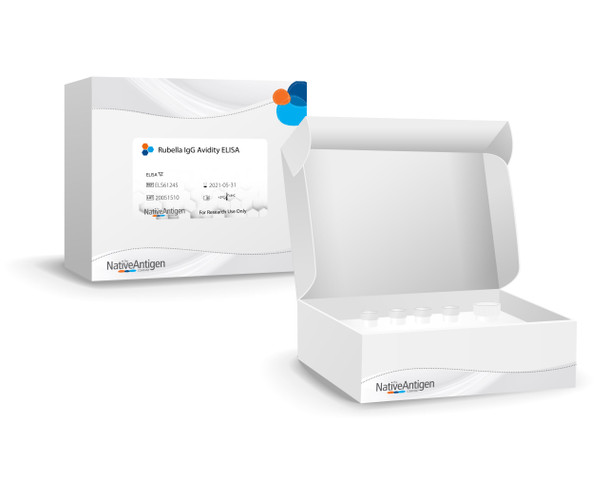Description
RUBELLA VIRUS IGG AVIDITY ELISA
Rubella Virus IgG Avidity immunoassay for the determination of Rubella-specific IgG avidity in human serum or plasma to differentiate between acute and past infection.
PRODUCT DETAILS – RUBELLA VIRUS IGG AVIDITY ELISA
- Rubella Virus IgG Avidity assay to differentiate between acute and past infection.
- Diagnostic performance was performed in comparison to well defined samples. The resulting relative agreement was 98.6%.
BACKGROUND
The presence of IgG antibodies to Rubella Virus indicates the occurrence of the infection but does not distinguish between recent and past infection. Virus-specific IgM antibodies are first detected approximately in ten days and peak at about four weeks post infection. They may persist for several months after acute infections. Based on the evidence that antibody avidity gradually increases after exposure to an immunogen, avidity of IgG antibodies can be used as a marker for distinguishing recent primary from long-term infections. Avidity describes the binding strength of a specific antibody to its antigen. Low-avidity IgG antibodies indicate a primary infection, whereas the presence of IgG antibodies with high avidity points to persistency or reactivation of infection.
The qualitative immunoenzymatic determination of specific antibodies is based on the ELISA (Enzyme-linked Immunosorbent Assay) technique. Microplates are coated with specific antigens to bind corresponding antibodies of the sample (dual pipetting). After washing the wells to remove all unbound sample material, one well is incubated with avidity reagent and the corresponding well with washing buffer. The avidity reagent removes the low-avidity antibodies from the antigens whereas the high-avidity ones are still bound to the specific antigens. After second washing step to remove the rest of avidity reagent and low-avidity antibodies, a horseradish peroxidase (HRP) labelled conjugate is added. This conjugate binds to the captured antibodies. In a third washing step unbound conjugate is removed. The immune complex formed by the bound conjugate is visualized by adding Tetramethylbenzidine (TMB) substrate which gives a blue reaction product. The intensity of this product is proportional to the amount of specific antibodies in the sample. Sulphuric acid is added to stop the reaction. This produces a yellow endpoint colour. Absorbance at 450/620 nm is read using an ELISA microwell plate reader.
REFERENCES
- Agbede, Olajide Olubunmi; Adeyemi, Oluwapelumi Olufemi; Olatinwo, Abdul Wahab Olanrewaju (2013): Significance of IgG-Avidity in Antenatal Rubella Diagnosis. In Journal of family & reproductive health 7 (3), pp. 131–137.
- Banatvala, J. E.; Brown, D. W.G. (2004): Rubella. In The Lancet 363 (9415), pp. 1127–1137. DOI: 10.1016/S0140-6736(04)15897-2.
- Inouye, Sakae; Hasegawa, Ayako; Matsuno, Shigeo; Katow, Shigetaka (1984): Changes in Antibody Avidity After Virus Infections: Detection by an Immunosorbent Assay in Which a Mild Protein-Denaturing Agent Is Employed. In Journal of Clinical Microbiology 20 (3), pp. 525–529.
THIS ELISA ASSAY IS FOR RESEARCH USE ONLY. IT IS NOT FOR USE IN DIAGNOSTIC PROCEDURES.













